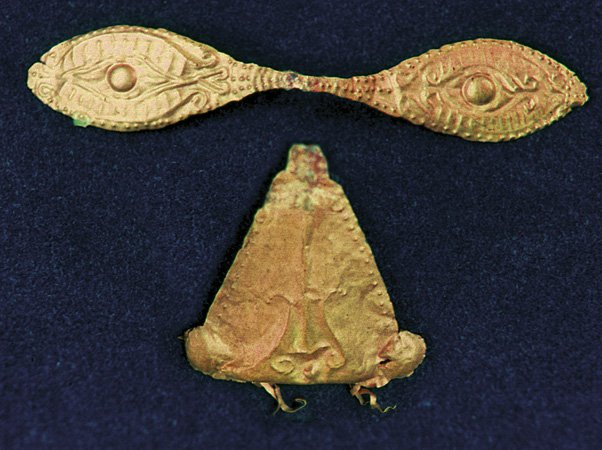Cultural Center of the Philippines
ENCYCLOPEDIA OF
PHILIPPINE ART
[Oton Face Covers/Oton Death Mask]
Late 14th to early 15th century / Gold / Eye cover length 13.3 cm, width 2.5 cm, weight 3.16 g / Nose cover length 16.3 cm, width 5.5 cm, weight 3.09 g / Inv. no. eye covers OT-MD-39; nose shield OT-MF-40 / Oton, Iloilo province, Central Philippines / National Museum of the Philippines collection
The Philippines is abundant in gold and while this precious metal cannot be scientifically dated, it may have been the first metal to be shaped. Older than iron, the earliest archaeologically excavated gold ornaments—beads from Guri Cave, Tabon Cave complex, southwestern Palawan—trace back to 500-300 BCE (Bunag-Gatbonton 2014). Perhaps because pothunters had often come ahead of scientists to ancient burial and settlement sites, archaeologists have rarely found gold artifacts.
In 1973, a team from the National Museum of the Philippines excavated gold face covers dated from the late 14th to the early 15th century in Katagman (now San Antonio), Oton, Iloilo. Called the [Oton Death Mask], the ensemble was the first of its kind to be systematically recovered and declared a National Cultural Treasure. So far, the largest quantities and the widest range of gold ornaments have emerged from Butuan and Surigao in northeastern Mindanao and in Samar in eastern Visayas.
Ancient Filipinos made two types of face covers for their high-ranking dead: (a) gold masks with the eyes, nostrils, and mouth cut out; and (b) gold sheets to cover orifices, sometimes accompanied by a diadem (ornamental headband). They cut and hammered pure gold sheets into shape, in some cases preparing these in situ as snippings were recovered close by. In other instances, they sewed the gold sheets onto a support as evidenced by perforations along the gold sheet borders. Because gold sheets sought to cover orifices that gold masks exposed, the two types may have represented differences in their notions of death (Miksic 2012, 252).
Gold masks for the dead can be found in many ancient cultures, but gold orifice covers are unique to Coastal China, Taiwan, and Island Southeast Asia (former and current Austronesian speakers). Reasons for employing gold face covers varied: to usher the dead into the ranks of their sacred ancestors, to show their divine radiance, or to protect them from the profane eyes of the living (John 2013). For some Austronesian speakers, the dead were potentially malignant spirits that resisted going away. Funeral practices up to ethnographic times called for confusing and preventing the spirit of the deceased from returning to haunt the living. Families and villagers would bundle corpses and transport them out of their homes through windows, spin them in circles, or follow circuitous routes to the burial site so that they would lose their way should they attempt to return. Great effort was thus placed in giving proper burials, so placing gold covers on the eyes, nose, and mouth of a high-ranking decease may have, in effect, served as protection for the living.
Written by Purissima Benitez-Johannot
Sources
Bunag-Gatbonton, Esperanza. 2014. “Kalinangan Pinanday sa Ginto: A Cultural History of the Function of Gold in Philippine Society.” PhD diss., University of the Philippines Diliman, Quezon City.
John, John N. 2013. “Philippine Gold in Early Southeast Asia.” Arts of Asia 43 (1): 78-88.
Miksic, John N. 2012. “Gold Face Covers.” In Paths of Origins: the Austronesian Heritage in the Collections of the National Museum of the
Philippines, the Museum Nasional Indonesia, and the Rijksmuseum voor Volkenkunde, edited by Purissima Benitez-Johannot.
Singapore and Manila: ArtPostAsia.
